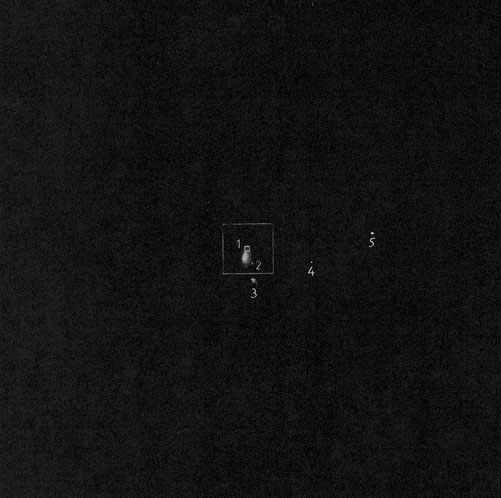
If we traveled at 17.3 km/s, it would take us 40,000,000,000 (or 40 billion!) years to get to the nearest galaxy that is like our own - the Andromeda Galaxy! This travel time is longer than scientists believe the Universe has been around. Knowing this, we can calculate that, at the distance of 5,000,000 parsecs (which is the radius of this circle), 0.1 arcsecond is about 2.5 parsecs.

* 1 arcsecond is a unit of angle that's 1/3600 of a degree. This makes it more difficult to study individual objects! So each pixel covers 2.5 by 2.5 arcseconds (times the 'thickness' of the galaxy) - which is likely to contain several stars at least. If the galaxy is 5,000,000 parsecs away, you can use trigonometry to figure out that 0.1 arcsecond corresponds to ~2.5 parsecs. Let's use something very small, like 0.1 arcsecond as our angle*. How can astronomers figure out how severe this crowding problem is? Each side of a picture element (pixel) defines an angle on the sky, determined by the design of the instrument.
#Cosmic view universe in 40 jumps Patch#
It's not just the apparent faintness of stars at such large distances the crowding of stars in a small patch of the sky is a more important problem. But even with the sharp vision of the Hubble Space Telescope, this can't be done much beyond the Local Group. We can actually study individual objects (ie a specific star) in Local Group galaxies, even at distances as great as 2,000,000 parsecs. Why Are These Distances Important To Astronomers? Other methods that are used to find the distances to galaxies can be found on the ABCs of Distance. Edwin Hubble used just such a star in the Andromeda Galaxy to find that the galaxy was more than a million light years away - much further than the most distant reaches of our own galaxy.įor more information about Cepheids, please read the section on calculating distances in the Milky Way.

How Do We Calculate Distances of This Magnitude?Ĭepheid Variable stars are used to calculate distances of this magnitude. This translates to 2.3 million light years, or 725 kpc. When we talk about the distances to other galaxies, we often use the units of kiloparsec (kpc) and Megaparsec (Mpc). It is also possible that the Local Group may one day merge with the next nearest big galaxy cluster, the Virgo Cluster. The dynamics of the Local Group are changing, and some astronomers speculated that one day the two large spirals in it (M31 and the Milky Way) may collide and merge to form a giant elliptical galaxy.

Both M31 and the Milky Way have dwarf galaxies associated with them. M31 and the Milky Way are the most massive members of the Local Group, with M33 being the 3rd largest. There are over 30 galaxies that are considered to be in the local group, and they are spread over a diameter of nearly 10 million light years, with the center of them being somewhere between the Milky Way and M31. It has two small satellite galaxies, M32 and M110.Īlso prominent in the local group is the Triangulum Galaxy (M33), Leo I, and NGC 6822. Often it is this Awakening ability that makes all the difference.One of the most prominent members of the Local group is M31, the Andromeda Galaxy. Characters also have an Awaken meter, which, when full, unleashes their Awakening ability. Those that have played the likes of J-Stars Victory VS will know what to expect.Ī Jump Force match is concluded when one team reduces the other’s health bar to zero. Gameplay in Jump Force takes the form of 1-v-1 battles, where players control a team of three characters, which can be switched between during each fight to provide support to the active character. All you need to know about it is that the titular Jump Force has been assembled to defeat the Venoms, an army of automatons led by Kane and Galena. In the game, you play as a new Hero that’s been introduced to a world where numerous anime and manga IPs collide. Jump Force was launched in February 2019 for Windows, PlayStation 4 and Xbox One, with a Nintendo Switch port following in August 28 2020. After browsing our Jump Force tier list, you should have a pretty good idea which characters to choose for the battles ahead. Fighters include the likes of Naruto, Sasuke, Luffy, Zoro, Goky, Frieza, Vegeta, Gon, Kurapika and Killua, hailing of course from such franchises as Dragon Ball, Dragon Quest, Fist of the North Star, Yu-Gi-Oh and more. Developed by Spike Chunsoft and published by Bandai Namco, Jump Force is a fighting game that combines different characters from popular manga and anime.


 0 kommentar(er)
0 kommentar(er)
